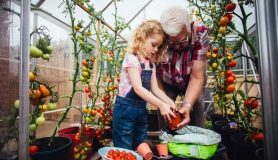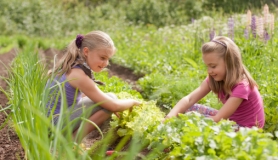GATHER Plastic vessel or container (glass with a lid is preferable); gravel or pebbles; phagnum moss; horticultural charcoal; commercial (sterilised) potting mix; tropical and sub-tropical plants; stones; driftwood; decorative items (optional)
Whether you want to green up your kitchen or living space, creating your own garden ecosystem in a terrarium is an instantly rewarding solution.
The list of moisture-loving plants suited for terrariums is long (and lyrical) – pepperomia, syngonium, fittonia, callathea, spiderwort, parlour palms, club moss, selaginella, silver sprinkles and baby’s tears…
METHOD
- Clean your container with an anti-bacterial agent (washing up liquid is often enough) to ensure there are no harmful bacteria, fungi or algae present.
- Start by adding a drainage layer of pebbles (most aquarium rocks will do the trick) to the bottom of the container. Make sure that you cannot see the bottom of your vessel through the drainage layer.
- Firmly press moist sphagnum moss over your pebbles, ensuring that there are no gaps around the sides of the container. This layer will prevent the above living layers from contaminating the drainage, whilst also ensuring a source of moisture and a damp environment for your terrarium plant roots above.
- Add a thin layer of horticultural charcoal, which will make sure your living layer (soil) doesn’t sour over time.
- Add your living layer of sterilised potting mix (most commercial potting mixes are already sterilised). You’ll need to add at least 3–4 cm (1–2 in) of soil, but you can add a little more to your vessel for a hilly look. It’s important that your soil is clean, otherwise fungi will quickly overrun your terrarium, due to its warm, damp environment.
- Add your plants to your soil layer in whatever layout you like. Be creative – try and imagine the end result as you go. Group your taller plants towards the middle of your vessel. You can remove up to half of any plant’s root ball (their root system, often shaped to the container they have grown up in) as they’ll still get plenty of water in the moist environment of your terrarium.
- Add stones, driftwood or other decorative items to your mini landscape as you see fit.
- Mist/spray water on your plants and decorative items, as well as the sides of your container. This amount of water, in combination with the moisture from the sphagnum moss layer, will be enough to feed your plants. If your terrarium has a lid, keep the lid off until the plants are dry to the touch, then cover.
TIP: Ensure your terrarium layers take up no more than a third of your container, so that there is plenty of room for your plants to grow and thrive.
More projects to connect you with nature every day can be found in 365 Nature by Anna Carlile (Hardie Grant)
TERRARIUM MAINTENANCE
Once made, you should not need to add any water to your terrarium for many months. If your terrarium does not have a lid, you will need to water it regularly as you would any house plant.
- Never over-water your terrarium. If you notice heavy condensation on the container lid or walls, remove the lid for up to a day at a time to allow the moisture to leave the vessel. If your plants are wilting, yellowing or look dry – mist them with your spray bottle.
- Prune any overgrown plants, especially if they’re growing up against the container walls as this can cause plants to rot and fester.
- Ensure your terrarium is placed in a brightly lit spot, at least 50 cm (20 in) away from any direct sunlight. Rotate your terrarium occasionally to ensure your plants are getting an even dosage of sun.







